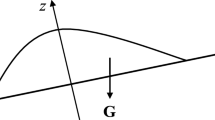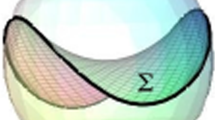Abstract
The solution space of axisymmetric liquid drops attached to a horizontal plane is investigated, and the stability of hydrostatic shapes is assessed by a novel numerical linear stability analysis involving discrete perturbations. For a given contact angle and Bond number, multiple interfacial shapes exist with compact, lightbulb, hourglass, and more convoluted pearly shapes. It is found that more than one solution branch can be stable, and that negative curvature at the contact line of a pendant drop is not a prerequisite for instability. Numerical simulations based on the boundary-integral method for Stokes flow illustrate the process of unstable drop detachment. Unstable drops transform into elongated threads with a spherical head whose volume is determined by a Bond number expressing the significance of surface tension. A complementary investigation of the shape and stability of two-dimensional drops attached to a horizontal or inclined plane reveals that hydrostatic shapes are least stable in the inclined configuration and most stable in the pendant or sessile configuration.
Similar content being viewed by others
References
Bashforth F, Adams JC (1883) An attempt to test the theories of capillary attraction. Cambridge University Press, Cambridge
Padday JF (1971) The profiles of axially symmetric menisci. Philos Trans R Soc Lond A 269: 265–293
Padday JF, Pitt AR (1971) Axisymmetric meniscus profiles. J Colloid Interface Sci 38: 323–334
Hartland S, Harley RW (1976) Axisymmetric fluid interfaces. Elsevier, Amsterdam
O’Brien SBG (1991) On the shape of small sessile and pendant drops by singular perturbation techniques. J Fluid Mech 233: 519–537
O’Brien SBG (1994) Asymptotic solutions for double pendant and extended sessile drops. Q Appl Math 52: 43–48
Finn R (1986) Equilibrium capillary surfaces. Springer-Verlag, New York
Homentcovschi D, Geer J, Singler T (1998) Uniform asymptotic solutions for small and large sessile drops. Acta Mech 128: 141–171
Finn R (2002) Some properties of capillary surfaces. Milan J Math 70: 1–23
Ferri JK, Kotsmar C, Miller R (2010) From surfactant adsorption kinetics to asymmetric nanomembrane mechanics: pendant drop experiments with subphase exchange. Adv Colloid Interface Sci. doi:10.1016/j.cis.2010.08.002
Padday JF, Pitt AR (1973) The stability of axisymmetric menisci. Philos Trans R Soc Lond A 275: 489–528
Schulkes RMSM (1994) The evolution and bifurcation of a pendant drop. J Fluid Mech 278: 83–100
Henderson D, Pritchard WG, Smolka LB (1999) On the pinch-off of a pendant drop of viscous fluid. Phys Fluids 9: 3188–3200
Lowry BJ, Steen PH (1995) Capillary surfaces: stability from families of equilibria with application to the liquid bridge. Proc R Soc Lond A 449: 411–439
Boucher EA, Evans MJB (1975) Pendent drop profiles and related capillary phenomena. Proc R Soc Lond A 346: 349–374
Boucher EA, Evans MJB, Kent HJ (1976) Capillary phenomena. II. Equilibrium and stability of rotationally symmetric fluid bodies. Proc R Soc Lond A 349: 81–100
Boucher EA (1980) Capillary phenomena: properties of systems with fluid/fluid interfaces. Rep Prog Phys 43: 497–546
Wente HC (1980) The stability of the axially symmetric pendent drop. Pac J Math 88: 421–470
Pozrikidis C (2011) Introduction to theoretical and computational fluid dynamics, 2nd edn. Oxford University Press, Oxford
Pozrikidis C (2009) Fluid dynamics: theory, computation and numerical simulation, 2nd edn. Kluwer Academic Publishers, Norwell
Pozrikidis C (2008) Numerical computation in science and engineering, 2nd edn. Oxford University Press, Oxford
Pozrikidis C (1992) Boundary integral and singularity methods for linearized viscous flow. Cambridge University Press, Cambridge
Pozrikidis C (2001) A practical guide to boundary-element methods with the software library BEMLIB. Chapman & Hall/CRC, Boca Raton
Papageorgiou DT (1995) Analytical description of the breakup of liquid jets. J Fluid Mech 301: 109–132
Chen TY, Tsamopoulos JA, Good RJ (1992) Capillary bridges between parallel and non-parallel surfaces and their stability. J Colloid Interface Sci 151: 49–69
Author information
Authors and Affiliations
Corresponding author
Rights and permissions
About this article
Cite this article
Pozrikidis, C. Stability of sessile and pendant liquid drops. J Eng Math 72, 1–20 (2012). https://doi.org/10.1007/s10665-011-9459-3
Received:
Accepted:
Published:
Issue Date:
DOI: https://doi.org/10.1007/s10665-011-9459-3




